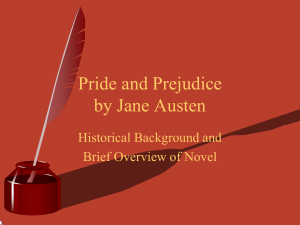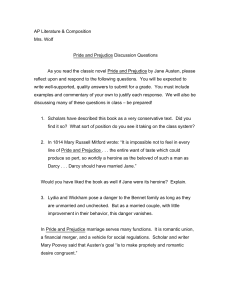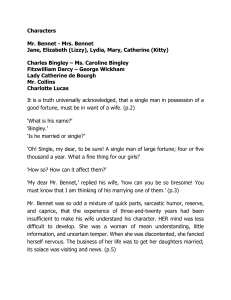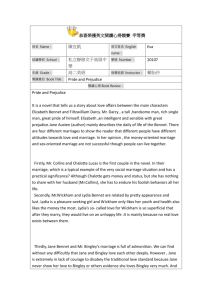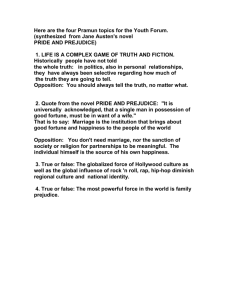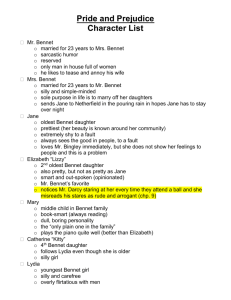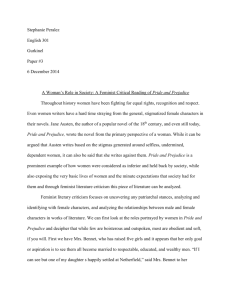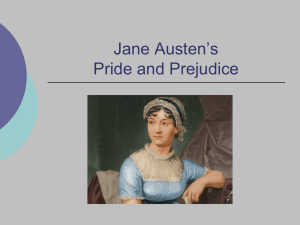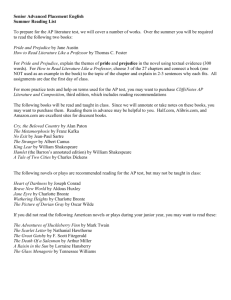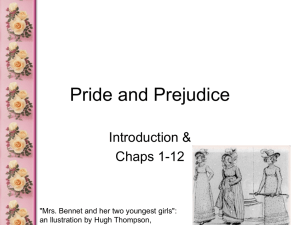Pride and Prejudice by Jane Austen
advertisement
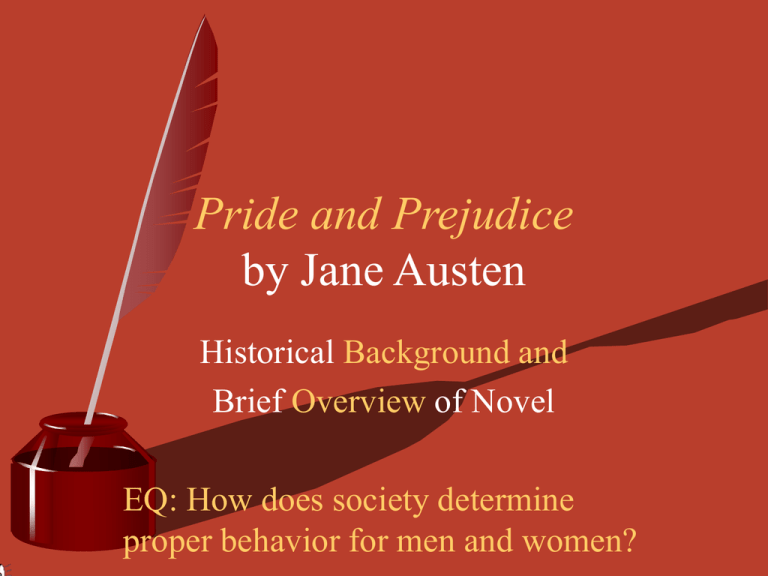
Pride and Prejudice by Jane Austen Historical Background and Brief Overview of Novel EQ: How does society determine proper behavior for men and women? Pride and Prejudice Pride and Prejudice was written between October 1796 and August 1797; it was Austen’s first novel and most famous work. It was not published, however, until 1813, two years after Sense and Sensibility. Austen other novels are Northanger Abbey, Mansfield Park, Emma, and Persuasion. Pride and Prejudice “It is truth acknowledged, that a single man in possession of a good fortune, must be in want of a wife.” Women in the 18th Century Marriage was a central concern in the early nineteenth century: middle and upper-class women to have a tolerable existence. Men ruled the public world of politics and business; women ruled the home. Women in the 18th Century Rigid guidelines of respectable married women They never went out alone (especially not in the city and not at night) They spent their days supervising servants They did needlepoint They made or received visits They thought of little besides fashion and society Women in the 18th Century Unmarried women of good birth had an even more difficult time They could only rarely inherit property Most fortunes were willed to eldest son As in the case with the Bennet family, great estates were frequently “entailed” on the male line, no sons = someone else getting property Women in the 18th Century No matter how elevated her background, a penniless young woman who did not marry was often forced to live with married sisters or live on a meager income. Treated as a servant Only careers as governesses or school teachers Required to care for infants or do the sewing These girls in the highest ranks were forced to earn their living Women’s Accomplishments Instead of a formal education, women learned accomplishments = acquired skills to attract a man Reading Playing a musical instrument Singing Drawing Speak modern languages (generally Italian or French) And the story goes… Mrs. Bennet’s overriding concern with the marriages of her five daughters is thus typical of the panic many 19th century mothers felt (shocking). Mr. Bennet’s estate is entailed to his distant cousin A single man, Charles Bingley, has leased Netherfield Park and his best friend is Fitzwilliam Darcy Possibility for the middle class Bennet girls to catch a man Jane Elizabeth Mary Catherine (Kitty) Lydia Setting The story takes place in a series of small villages in England at the close of the 18th century The novel opens in the Bennet home at the estate Longbourn, located about a mile from Meryton, the nearest town Chapter 3 takes place at Netherfield Park, Bingley’s rented estate The setting alternates between Longbourn and Netherfield Park with occasional mention of other various locations Themes Marriage vs. Love During this time many believed that marriage was a business transaction Pay attention to characters’ discussion of marriage Social Rank & Reputation One’s social class determined expected behaviors Both men and women had certain behavioral rules to follow Elizabeth Bennet challenges expected rules for women and social rank Pride Having too much pride is negative in this novel Pride = arrogance; self-conceit Characters describe Darcy as proud Prejudice Prejudice in the novel refers to judging others Characters form first impressions that are often wrong These impressions can cloud a character’s judgment of other people Your Cornell Notes (15 points for each reading assignment) Quotes for 3 out of the 4 themes Examples of character development for the major characters, labeled dir/ind: Eliz, Darcy, Jane, Bingley, Bingley sisters Summary of the chapters at the bottom in the summary box. characters Netherfield: Mr. Charles Bingley & Mr. Fitzwilliam Darcy Netherfield: Miss Caroline Bingley: miss bingley Netherfield: Mrs. Hurst (Bingley’s other sister) cuz she’s married to Mr. Hurst
